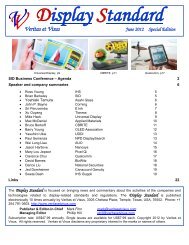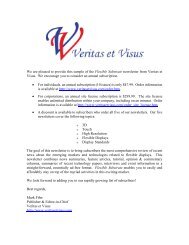Create successful ePaper yourself
Turn your PDF publications into a flip-book with our unique Google optimized e-Paper software.
<strong>Veritas</strong> <strong>et</strong> <strong>Visus</strong> <strong>Display</strong> <strong>Standard</strong> February 2009<br />
Active Optical Cables Mark<strong>et</strong> Report 2009<br />
101<br />
by Tom Rossi<br />
Tom Rossi has run his technology consulting company since June 2008. Prior to that, he<br />
worked for Intel Corporation for over 30 years in a vari<strong>et</strong>y of engineering, mark<strong>et</strong>ing<br />
and strategic planning roles, including his most recent position with Intel’s Connects<br />
Cable product group. Tom has spent 15 years with the notebook computer industry,<br />
including eight years working with the flat panel supplier industry and several standards<br />
groups supporting computer displays. He was part of the initial workgroup that crafted<br />
the early versions of what is now know as <strong>Display</strong>Port, and was instrumental in gaining<br />
support for key features that improve design capability for active optical cable providers<br />
within VESA’s <strong>Display</strong>Port Hybrid Device sub-group. Tom holds two US patents related<br />
to the flat panel displays used inside so many notebook computers today. He graduated<br />
from Cornell University with honors, and holds a Masters and Bachelors degree from<br />
their Electrical Engineering school, with an emphasis on advanced computer<br />
architecture.<br />
Active optical cables offer a significant leap in performance over their copper cable cousins. While they are aimed<br />
to connect to the same electrical interfaces, their innate design characteristics allow them to offer their users<br />
significant benefits, including:<br />
� Longer effective cable length limits<br />
� Lighter, thinner, more flexible cables<br />
� Far b<strong>et</strong>ter low bit-error-rate (BER) and EMI/RFI characteristics<br />
In our latest edition of the Active Optical Cables: Mark<strong>et</strong> Report 2009, we illustrated four separate bus interfaces<br />
poised to capitalize on recent advances in optoelectronics:<br />
� InfiniBand<br />
� HDMI<br />
� USB<br />
� <strong>Display</strong>Port<br />
These interfaces were chosen for our analysis since the underling active optical cable designs could share number<br />
of core elements, into the optoelectronics devices and the optical fibers, posing a strong “adjacency factor” for the<br />
various designs and mark<strong>et</strong> segments. Thus as one portion starts to surge in volume demand, so will other segments<br />
benefit from overall material cost reductions caused by their adjacency.<br />
Several key high-volume applications segments were studied in this report. Emphasis was given to digital interfaces<br />
running either at or above 5Gbps, as well as those demanding extended cable lengths beyond a few m<strong>et</strong>er at these<br />
speeds. The particular application segments covered in this report include:<br />
� Mainframe/supercomputer (HPCC)<br />
� Desktop and notebook/portable personal computers (PC)<br />
� High-definition television (HDTV)<br />
� Consumer electronics devices (CE)<br />
We created an innovative tool call PowerForecaster that helped us build our entire forecast data into a single<br />
correlated database, with over 130 charts and data tables built from the same core forecasts. As we gathered new<br />
information, it became a fairly trivial exercise to re-build the entire datas<strong>et</strong> and graphical illustrations used inside<br />
the 170+ page report. Additional tools were created to help transfer each of the charts from our master Excel<br />
foundation into highly structured and stylized Word documents, making the publication much simpler to create that<br />
found from other research companies. We also have an added benefit of being able to rapidly create numerous new






